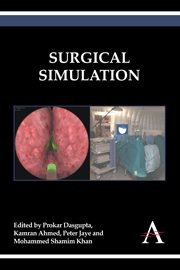Book contents
- Frontmatter
- Contents
- 1 Surgical Simulation: An Overview
- 2 Simulation in Historical Perspective: The History of Medical and Surgical Simulation
- 3 The Role of Animal Models in Surgical Training and Assessment
- 4 Full Procedural Surgical Simulation
- 5 Developing Non-technical Skills
- 6 Learning Curves for Simulators
- 7 Developing a Simulation Programme
- 8 Patient Safety and Simulation
- 9 Psychometrics
- 10 Future of Surgical Simulation
- Author Details
10 - Future of Surgical Simulation
Published online by Cambridge University Press: 05 April 2014
- Frontmatter
- Contents
- 1 Surgical Simulation: An Overview
- 2 Simulation in Historical Perspective: The History of Medical and Surgical Simulation
- 3 The Role of Animal Models in Surgical Training and Assessment
- 4 Full Procedural Surgical Simulation
- 5 Developing Non-technical Skills
- 6 Learning Curves for Simulators
- 7 Developing a Simulation Programme
- 8 Patient Safety and Simulation
- 9 Psychometrics
- 10 Future of Surgical Simulation
- Author Details
Summary
Current Developments in Simulation Models for Surgical Skills Training
In 1892, Professor William Halsted introduced the first apprenticeship system for surgical training at Johns Hopkins Hospital, Baltimore. The modernisation of medical careers and shorter training programmes have challenged this traditional approach, and in recent years surgical education and training have developed into a curriculum-based system to ensure that students acquire core skills to gain a basic proficiency in surgery (1). Advances in medical technology, the evolution of laparoscopic surgery and the introduction of Working Time Directives have dictated changes to the system of surgical training and identified an increased need for the safe, controlled practice of simulation and simulators that are specific to surgical training (1–4).
Learning by procedure-based simulators has definite advantages over performing operative procedures and practising on patients (Figures 10.1– 10.3) (5). Simulation enables the surgical trainee to acquire essential skills and progress along a proficiency curve before attempting a real procedure, and provides them with a low-risk environment in which to rehearse and practise their technique without stress or tight time constraints (1–7).
Learning by simulation models allows surgical trainees to commit errors that are an essential component of the learning process (8–11). These simulated systems are also valuable for surgical skills assessment because they enable standardised training through the repeated practice of skills and procedures under standardised conditions (12).
- Type
- Chapter
- Information
- Surgical Simulation , pp. 111 - 122Publisher: Anthem PressPrint publication year: 2014

